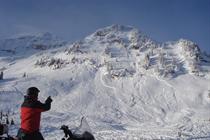Weak snow layers cause for concern for backcountry users
The Canadian Avalanche Centre (CAC) is issuing a special avalanche warning for most of the mountainous regions of south and central BC. The warning is in effect immediately, through the weekend to end of day Monday, Jan. 24.
The warning applies to the South Coast Mountains east of Pemberton (Duffy Lake region); the South Chilcotin Mountains (Bridge River, Carpenter Lake, Anderson Lake area); the Columbia Mountains from the US border to Prince George; the North Rockies, north and east of Prince George (including areas around Mackenzie, Chetwynd, Pine Pass, Tumbler Ridge, and Kakwa Provincial Park); the Southern Rockies forecast region; the Mountain National Parks (Rogers Pass, Banff, Yoho, Kootenay, Jasper and Waterton Lakes); and Alberta’s Kananaskis Country. For a map of the warning area, go here: avalanche.ca/spaw/2011-01-21.
AC Public Avalanche Warning Services Manager Karl Klassen says the main concern is weak layers deeply buried in the snowpack. “The nature of these layers is a bit of a mixed bag,” he explains.
“Different regions have different problems but the fundamental concern applies across the board—there’s up to two metres of new snow sitting on some kind of fragile layer. That new snow is starting to settle so natural avalanche activity is slowing down. Without natural avalanches as a warning sign, and with the settled snow offering easier traveling conditions, backcountry users may be tempted to push into more aggressive terrain, which could be a deadly choice.”
The CAC is urging all recreational backcountry users to stay away from large, steep and complex slopes. When triggered, avalanches are expected to be large, often running much farther than expected. Avoid avalanche terrain in the alpine. If you do go into the backcountry, stick to small, simple terrain below treeline and stay out of avalanche runout zones.
Everyone in the party needs an avalanche beacon, probe and shovel and at least basic avalanche training. Group leaders need advanced training and everyone should check the current conditions at avalanche.ca before heading out.
For an introduction to avalanche training, take the CAC’s online avalanche course: avalanche.ca/cac/training/online-course.






















